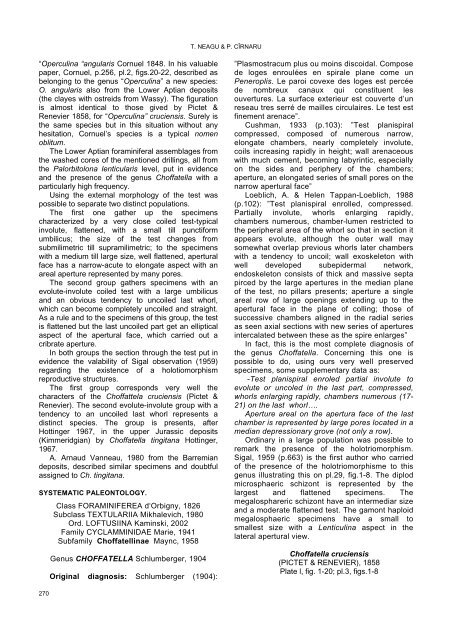GENUS CHOFFATELLA (SCHLUMBERGER), 1904 ...
GENUS CHOFFATELLA (SCHLUMBERGER), 1904 ...
GENUS CHOFFATELLA (SCHLUMBERGER), 1904 ...
You also want an ePaper? Increase the reach of your titles
YUMPU automatically turns print PDFs into web optimized ePapers that Google loves.
T. NEAGU & P. CÎRNARU<br />
“Operculina “angularis Cornuel 1848. In his valuable<br />
paper, Cornuel, p.256, pl.2, figs.20-22, described as<br />
belonging to the genus “Operculina” a new species:<br />
O. angularis also from the Lower Aptian deposits<br />
(the clayes with ostreids from Wassy). The figuration<br />
is almost identical to those gived by Pictet &<br />
Renevier 1858, for “Operculina” cruciensis. Surely is<br />
the same species but in this situation without any<br />
hesitation, Cornuel’s species is a typical nomen<br />
oblitum.<br />
The Lower Aptian foraminiferal assemblages from<br />
the washed cores of the mentioned drillings, all from<br />
the Palorbitolona lenticularis level, put in evidence<br />
and the presence of the genus Choffatella with a<br />
particularly high frequency.<br />
Using the external morphology of the test was<br />
possible to separate two distinct populations.<br />
The first one gather up the specimens<br />
characterized by a very close coiled test-typical<br />
involute, flattened, with a small till punctiform<br />
umbilicus; the size of the test changes from<br />
submilimetric till supramilimetric; to the specimens<br />
with a medium till large size, well flattened, apertural<br />
face has a narrow-acute to elongate aspect with an<br />
areal aperture represented by many pores.<br />
The second group gathers specimens with an<br />
evolute-involute coiled test with a large umbilicus<br />
and an obvious tendency to uncoiled last whorl,<br />
which can become completely uncoiled and straight.<br />
As a rule and to the specimens of this group, the test<br />
is flattened but the last uncoiled part get an elliptical<br />
aspect of the apertural face, which carried out a<br />
cribrate aperture.<br />
In both groups the section through the test put in<br />
evidence the valability of Sigal observation (1959)<br />
regarding the existence of a holotiomorphism<br />
reproductive structures.<br />
The first group corresponds very well the<br />
characters of the Choffattela cruciensis (Pictet &<br />
Renevier). The second evolute-involute group with a<br />
tendency to an uncoiled last whorl represents a<br />
distinct species. The group is presents, after<br />
Hottinger 1967, in the upper Jurassic deposits<br />
(Kimmeridgian) by Choffatella tingitana Hottinger,<br />
1967.<br />
A. Arnaud Vanneau, 1980 from the Barremian<br />
deposits, described similar specimens and doubtful<br />
assigned to Ch. tingitana.<br />
SYSTEMATIC PALEONTOLOGY.<br />
Class FORAMINIFEREA d‘Orbigny, 1826<br />
Subclass TEXTULARIIA Mikhalevich, 1980<br />
Ord. LOFTUSIINA Kaminski, 2002<br />
Family CYCLAMMINIDAE Marie, 1941<br />
Subfamily Choffatellinae Maync, 1958<br />
Genus <strong>CHOFFATELLA</strong> Schlumberger, <strong>1904</strong><br />
Original diagnosis: Schlumberger (<strong>1904</strong>):<br />
”Plasmostracum plus ou moins discoidal. Compose<br />
de loges enroulées en spirale plane come un<br />
Peneroplis. Le paroi covexe des loges est percée<br />
de nombreux canaux qui constituent les<br />
ouvertures. La surface exterieur est couverte d’un<br />
reseau tres serré de mailles circulaires. Le test est<br />
finement arenace”.<br />
Cushman, 1933 (p.103): ”Test planispiral<br />
compressed, composed of numerous narrow,<br />
elongate chambers, nearly completely involute,<br />
coils increasing rapidly in height; wall arenaceous<br />
with much cement, becoming labyrintic, especially<br />
on the sides and periphery of the chambers;<br />
aperture, an elongated series of small pores on the<br />
narrow apertural face”<br />
Loeblich, A. & Helen Tappan-Loeblich, 1988<br />
(p.102): ”Test planispiral enrolled, compressed.<br />
Partially involute, whorls enlarging rapidly,<br />
chambers numerous, chamber-lumen restricted to<br />
the peripheral area of the whorl so that in section it<br />
appears evolute, although the outer wall may<br />
somewhat overlap previous whorls later chambers<br />
with a tendency to uncoil; wall exoskeleton with<br />
well developed subepidermal network,<br />
endoskeleton consists of thick and massive septa<br />
pirced by the large apertures in the median plane<br />
of the test, no pillars presents; aperture a single<br />
areal row of large openings extending up to the<br />
apertural face in the plane of colling; those of<br />
successive chambers aligned in the radial series<br />
as seen axial sections with new series of apertures<br />
intercalated between these as the spire enlarges”<br />
In fact, this is the most complete diagnosis of<br />
the genus Choffatella. Concerning this one is<br />
possible to do, using ours very well preserved<br />
specimens, some supplementary data as:<br />
-Test planispiral enroled partial involute to<br />
evolute or uncoled in the last part, compressed,<br />
whorls enlarging rapidly, chambers numerous (17-<br />
21) on the last whorl….<br />
Aperture areal on the apertura face of the last<br />
chamber is represented by large pores located in a<br />
median depressionary grove (not only a row).<br />
Ordinary in a large population was possible to<br />
remark the presence of the holotriomorphism.<br />
Sigal, 1959 (p.663) is the first author who carried<br />
of the presence of the holotriomorphisme to this<br />
genus illustrating this on pl.29, fig.1-8. The diplod<br />
microsphaeric schizont is represented by the<br />
largest and flattened specimens. The<br />
megalosphareric schizont have an intermediar size<br />
and a moderate flattened test. The gamont haploid<br />
megalosphaeric specimens have a small to<br />
smallest size with a Lenticulina aspect in the<br />
lateral apertural view.<br />
Choffatella cruciensis<br />
(PICTET & RENEVIER), 1858<br />
Plate l, fig. 1-20; pl.3, figs.1-8<br />
270
















